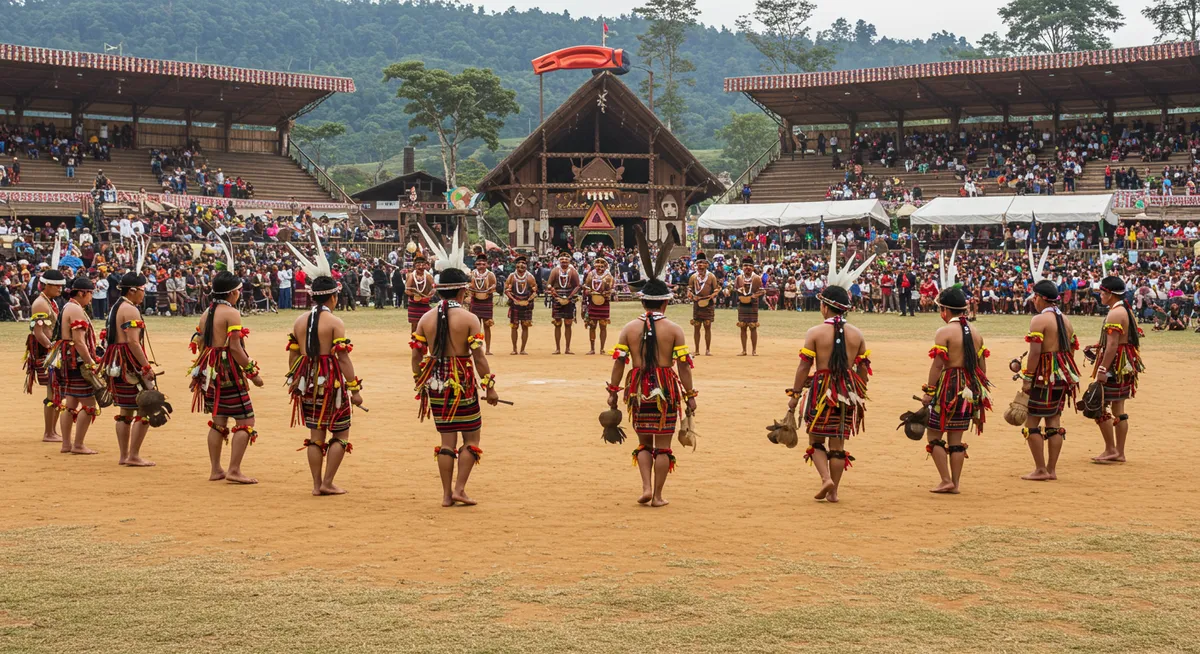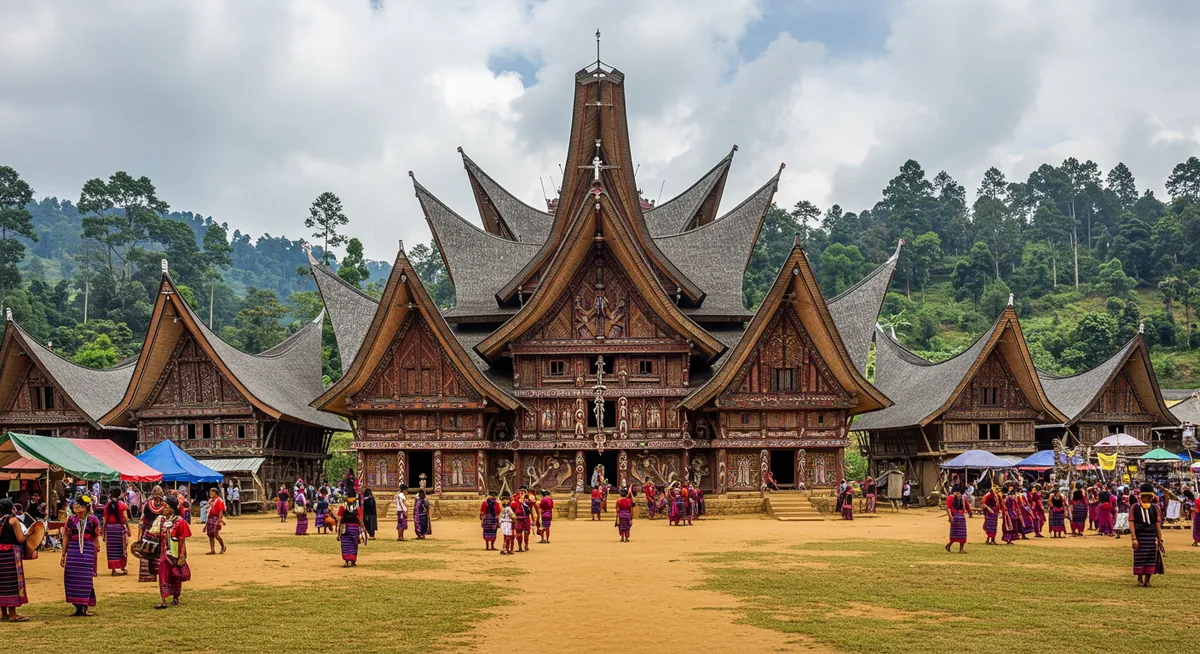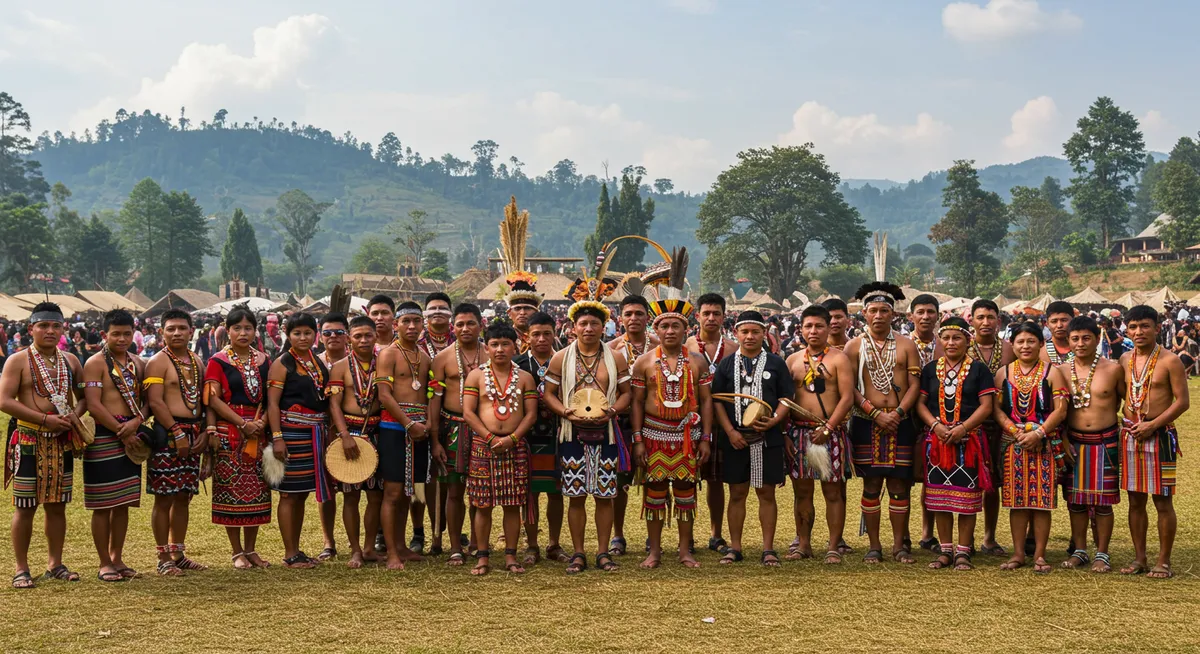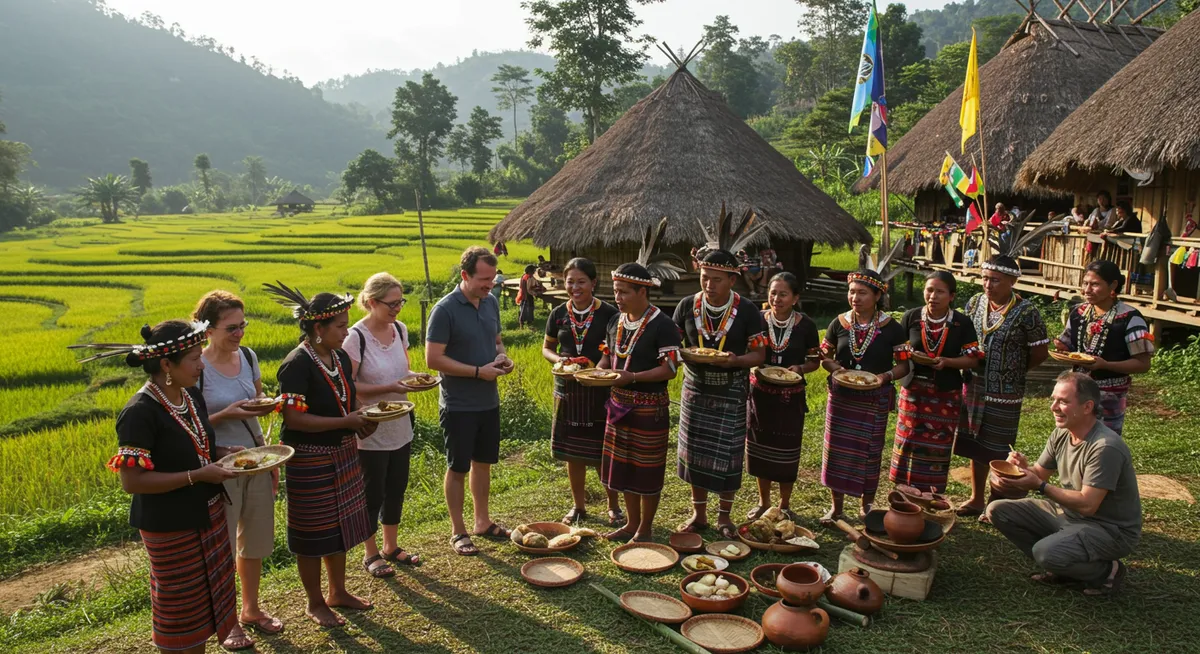Hornbill Festival Nagaland | Festival of Festivals | Tribal Heritage

Hornbill Festival: India's Spectacular Celebration of Indigenous Tribal Heritage
Every December, in the verdant hills of Nagaland in India's remote northeast, an extraordinary cultural spectacle unfolds. The Hornbill Festival brings together 16 diverse indigenous tribes for a ten-day celebration so rich in tradition and cultural expression that it has earned the title "Festival of Festivals." Set against the backdrop of Kisama Heritage Village near the capital Kohima, this vibrant gathering showcases the distinctive traditions, rituals, songs, dances, and crafts of Naga tribes that were once feared headhunters but now welcome visitors to experience their remarkable cultural heritage. For travelers seeking authentic cultural immersion, the Hornbill Festival offers a rare opportunity to witness multiple indigenous communities simultaneously sharing their ancestral practices with pride and joy in one of India's most unique and spectacular celebrations.

Origins and Significance
The Hornbill Festival represents both ancient heritage and modern cultural revival:
Festival Foundations
The event emerged from significant cultural and historical contexts:
- Modern Creation: Officially established in 2000 by the Government of Nagaland to promote cultural heritage and tourism
- Ancient Roots: While the festival format is recent, it showcases traditions and practices that span countless generations
- Symbolic Timing: Coincides with Nagaland statehood day (December 1) and traditional post-harvest celebration period
- Named Symbol: The hornbill bird holds deep cultural significance for Naga tribes, featuring prominently in folklore and traditional decorative arts
Cultural Preservation
The festival serves crucial cultural preservation functions:
- Revitalization Effort: Helps reverse cultural erosion caused by modernization and outside influences
- Identity Affirmation: Strengthens tribal identity and pride, especially among younger generations
- Documentation: Creates opportunities to record and archive traditional knowledge, practices, and artistic expressions
- Intercultural Exchange: Promotes understanding between Nagaland's different tribes, who historically lived in relative isolation
The Festival Experience
The Hornbill Festival offers a comprehensive immersion into Naga culture:
Tribal Morungs
The festival's physical and cultural heart:
- Traditional Structures: Each participating tribe constructs and maintains a morung (traditional communal house) at the festival grounds
- Living Museums: Morungs serve as living showcases of tribal architecture, artifacts, and daily life
- Hospitality Centers: Visitors are welcomed into morungs to sample tribal cuisine, rice beer, and cultural demonstrations
- Distinctive Design: Each morung reflects unique architectural traditions with elaborate wood carvings, bamboo work, and symbolic decorations

Cultural Performances
Daily showcases of traditional performing arts:
- War Dances: Dynamic expressions of traditional warrior culture with synchronized movements and battle cries
- Harvest Celebrations: Rhythmic dances and songs celebrating agricultural cycles and success
- Folk Songs: Traditional music performed with indigenous instruments, often accompanied by narrative storytelling
- Ceremonial Reenactments: Demonstrations of coming-of-age rituals, marriage ceremonies, and religious practices
- Cultural Competitions: Tribes compete in various cultural presentations, adding excitement to performances
Traditional Games and Sports
Ancient competitions demonstrate physical prowess and skill:
- Naga Wrestling: A prestigious combat sport with specific traditional rules and techniques
- Chilli Eating Contests: Entertaining challenges involving Nagaland's famously hot "Raja Mircha" ghost peppers
- Bamboo Climbing: Tests of agility scaling greased bamboo poles
- Stilt Walking: Demonstrations of balance and coordination using traditional bamboo stilts
- Indigenous Archery: Precision competitions using traditional bows and techniques
Crafts and Heritage Arts
Exceptional indigenous craftsmanship on display:
- Textile Traditions: Distinctive tribal weaving with complex patterns specific to different tribes and social statuses
- Woodcarving: Intricate sculptural techniques creating ceremonial objects, household items, and decorative pieces
- Bamboo and Cane Craft: Sophisticated utilitarian and artistic works using the region's abundant bamboo
- Jewelry Making: Traditional adornments using beads, shells, animal parts, and metalwork
- Live Demonstrations: Master artisans showcase techniques and offer interactive experiences for visitors
Culinary Traditions
Unique food experiences reveal Naga gastronomic heritage:
- Tribal Food Stalls: Each morung offers distinctive tribal specialties
- Fermentation Techniques: Traditional preservation methods create unique flavors
- Bamboo Cooking: Foods cooked inside bamboo tubes over open fires
- Local Ingredients: Indigenous herbs, vegetables, and meats rarely encountered elsewhere
- Rice Beer Varieties: Each tribe produces distinctive fermented rice beverages (zutho) with ceremonial importance
The Participating Tribes
The festival showcases Nagaland's remarkable cultural diversity:
Major Tribal Participants
Each tribe brings distinctive traditions to the gathering:
- Angami: Known for elaborate terrace farming, distinctive textiles, and the famous Sekrenyi festival
- Ao: Recognized for rich oral traditions, melodic folk songs, and the Moatsu festival
- Chakhesang: Masters of terraced agriculture, polyphonic singing, and distinctive shawl designs
- Konyak: Once feared headhunters, notable for facial tattoos, blacksmithing skills, and distinctive jewelry
- Lotha: Known for colorful ceremonial dress, harvest celebrations, and basketry
- Sumi: Renowned for warrior traditions, distinctive pottery, and vibrant dance performances
- Plus ten other tribes: Including Khiamniungan, Chang, Phom, Yimchunger, Zeliang, Pochury, Rengma, Sangtam, Tikhir, and Kuki
Cultural Distinctiveness
Despite proximity, Naga tribes maintain unique identities:
- Linguistic Diversity: Each tribe speaks a different language, often unintelligible to other Naga groups
- Visual Identifiers: Distinctive shawl patterns, headdresses, and jewelry that traditionally signified tribal affiliation
- Architectural Variations: Unique housing styles and village layouts adapted to different terrains and cultural needs
- Ceremonial Differences: Distinctive ritual practices, festival calendars, and spiritual traditions

Beyond the Main Festival
The Hornbill Festival has expanded to include contemporary elements:
Music and Arts Extensions
Modern cultural expressions complement traditional showcases:
- Hornbill Music Festival: One of India's largest rock concerts, featuring local and international performers
- Hornbill International Film Festival: Showcases indigenous cinema and documentaries about Northeast India
- Literary Events: Book releases, poetry readings, and discussions focusing on Naga culture and history
- Fashion Shows: Contemporary designers present modern interpretations of traditional tribal textiles and designs
- Art Exhibitions: Visual arts displays by Naga and Northeastern Indian artists
Adventure and Nature Components
The natural environment enhances the cultural experience:
- Hornbill Cycle Rally: Mountain biking event through Nagaland's scenic terrain
- Naga King Chilli Eating Competition: Challenge featuring one of the world's hottest peppers
- Motor Rally: Off-road driving event showcasing Nagaland's challenging landscapes
- Guided Nature Walks: Exploration of the region's rich biodiversity and medicinal plants
- Photography Expeditions: Organized tours to capture the region's natural and cultural beauty
Experiencing the Festival as a Visitor
Planning enhances this unique cultural experience:
Practical Information
Essential details for visitors:
- Festival Dates: December 1-10 annually
- Location: Kisama Heritage Village, approximately 12km from Kohima, Nagaland's capital
- Daily Schedule: Cultural performances and activities run from approximately 9:00 AM to 4:00 PM daily
- Entry Fees: Modest entrance fees with separate charges for special events and evening programs
- Photography Permits: Special passes may be required for professional photography and filming
Travel Logistics
Reaching this remote region requires planning:
- Nearest Airport: Dimapur Airport (approximately 74km from Kohima) with limited flight connections to major Indian cities
- Railway Access: Dimapur is the nearest railway station with connections to Guwahati and other northeastern cities
- Road Travel: Buses and shared taxis operate between Dimapur and Kohima (3-4 hour journey)
- Festival Transport: Special shuttles typically run between Kohima and the festival grounds during the event
- Inner Line Permit: Foreign visitors require special permits to enter Nagaland, obtainable online or through certain offices
Accommodation Options
Where to stay during the festival:
- Kohima Hotels: The capital offers the widest range of accommodation, though availability is limited during the festival
- Homestays: Family stays in Kohima and surrounding villages provide cultural immersion
- Festival Camping: Temporary accommodations are sometimes available near the festival site
- Advance Booking: Reservations at least 3-6 months in advance are essential due to limited options
Cultural Etiquette
Respectful participation enhances the experience:
- Photography Considerations: Always ask permission before photographing individuals, especially elders
- Appropriate Dress: Modest clothing is appreciated, particularly when visiting traditional morungs
- Accepting Hospitality: When offered food or drink in morungs, accepting at least a small amount is considered polite
- Tribal Interactions: Basic greetings in local languages are greatly appreciated
- Sacred Items: Some displayed artifacts may have spiritual significance requiring respectful behavior

Cultural Context and Significance
Understanding Nagaland enhances appreciation of the festival:
Historical Background
The region's complex history shapes its cultural expression:
- Traditional Isolation: Mountainous terrain historically limited external influence, preserving unique cultural practices
- Headhunting Heritage: Until the early 20th century, many tribes practiced headhunting as part of warrior traditions
- Christian Influence: American Baptist missionaries arrived in the 1870s, creating a unique blend of Christianity and indigenous practices
- Colonial Impact: British rule gradually expanded into the region, bringing significant changes to traditional governance
- Post-Independence Struggles: Complex relationship with India following independence, including periods of conflict
Contemporary Context
Modern challenges and adaptations influence the festival:
- Cultural Preservation: The festival emerged partly as a response to concerns about cultural loss among younger generations
- Tourism Development: Represents Nagaland's effort to showcase its unique heritage as an economic resource
- Reconciliation Symbol: Brings together diverse tribes with historically complex relationships
- International Recognition: Has significantly raised awareness of Naga culture globally
- Identity Affirmation: Strengthens collective Naga identity while celebrating tribal distinctiveness
Extending Your Nagaland Experience
The festival offers a gateway to further exploration:
Kohima and Surroundings
The capital region offers complementary experiences:
- Kohima War Cemetery: Moving memorial to the crucial WWII Battle of Kohima that halted the Japanese advance into India
- Kohima Cathedral: Asia's largest wooden cathedral, reflecting the region's Christian heritage
- Naga Heritage Village: The festival venue remains accessible year-round as a cultural exhibition
- Dzükou Valley: Spectacular trekking destination famous for its seasonal wildflower blooms
Deeper Exploration
For travelers with more time:
- Village Homestays: Extended immersion in traditional villages away from tourist centers
- Intangible Heritage: Opportunities to learn traditional skills like weaving or bamboo craft
- Longwa Village: Unique settlement straddling the India-Myanmar border where the tribal chief's house sits in both countries
- Tribal Markets: Weekly markets throughout Nagaland offer authentic glimpses of daily life and commerce
- Seasonal Festivals: Each tribe hosts its own traditional festivals throughout the year
Plan your Hornbill Festival experience
For the most authentic experience, plan to spend at least three full days at the festival, allowing time to visit all tribal morungs, witness the diverse performances, and participate in cultural workshops.
Secure accommodation in Kohima at least six months in advance, as the limited options fill quickly for this increasingly popular event that attracts visitors from across India and around the world.
Explore More Asian Cultural Festivals
If you're fascinated by the Hornbill Festival, discover other extraordinary Asian celebrations that showcase the continent's rich cultural heritage:
Rainforest World Music Festival
Malaysia's unique celebration of indigenous music traditions in a spectacular jungle setting.
Naadam Festival
Mongolia's celebration of nomadic culture with traditional wrestling, archery, and horse racing.
Esala Perahera
Sri Lanka's grand procession with decorated elephants, traditional dancers, and ancient Buddhist rituals.
Pushkar Camel Fair
India's colorful desert festival combining traditional livestock trading with cultural celebrations.
Holi Festival
India's vibrant spring celebration with colorful powder and joyous community gatherings.
Gion Matsuri
Japan's magnificent month-long festival with elaborate float processions and traditional arts.
Return to our Asian Cultural Festivals Guide to discover more extraordinary celebrations across the continent.